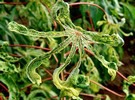Groundbreaking research led by Rebecca Bart, PhD, associate member, Nigel Taylor, PhD, associate member, Dorothy King, distinguished investigator, Donald Danforth Plant Science Center, and their collaborators at ETH Zurich, University of California Los Angeles, and the National Crops Resources Research Institute (NaCRRI) in Uganda, has identified a genetic mutation that confers resistance to cassava mosaic disease (CMD). Their findings have significant implications for improving cassava yield and sustaining farmer income in the face of a widespread disease, and their discovery could also shed light on disease resistance in other major crops. This seminal work, Mutations in DNA polymerase δ subunit 1 co-segregate with CMD2-type resistance to cassava mosaic geminiviruses, was recently published in the scientific journal Nature Communications.
Farmers in Africa, India, and Southeast Asia – some of the largest cassava-producing regions in the world – too often suffer huge yield losses due to CMD. CMD-infected plants are stunted and do not fully develop the storage roots that are used for food.
Several years ago, Taylor’s team unexpectedly discovered plants in the field that had lost resistance to CMD, thus triggering the present investigation into the genetic basis for resilience to the virus. “If CMD resistance hadn’t mysteriously been lost,” describes Bart, “we may never have gone after this project.” The researchers immediately knew they had discovered something important. With initial support from the Danforth Center’s Institute for International Crop Improvement, the Danforth team initiated experiments to discover the genetic basis for CMD resistance. The collaboration grew to include partners at NaCRRI, UCLA, and ETH-Zurich and was supported with additional funding from the Bill & Melinda Gates Foundation.
team unexpectedly discovered plants in the field that had lost resistance to CMD, thus triggering the present investigation into the genetic basis for resilience to the virus. “If CMD resistance hadn’t mysteriously been lost,” describes Bart, “we may never have gone after this project.” The researchers immediately knew they had discovered something important. With initial support from the Danforth Center’s Institute for International Crop Improvement, the Danforth team initiated experiments to discover the genetic basis for CMD resistance. The collaboration grew to include partners at NaCRRI, UCLA, and ETH-Zurich and was supported with additional funding from the Bill & Melinda Gates Foundation.
By identifying the exact genetic region that confers CMD resistance – in fact, down to a single nucleotide – their work sheds light on how resistance was acquired and how to maintain resistance to secure yields in the future. Additionally, similar viruses “attack many other crops, including cotton and tomato,” says Bart. “This discovery could provide disease-resistance strategies in those crops, too.” Studying cassava in the field is crucial to the researchers’ discoveries. For two years, the NaCRRI team grew cassava and documented disease prevalence in the field in Uganda – a recognized “hotspot” for CMD.
The discovery of a single mutation that confers resistance to CMD has opened the door for more questions and opportunities. First and foremost, explains Bart, “we need to understand the mechanism of how the mutation confers resistance.” Understanding the mechanism of resistance will likely shed light on how stable the resistance will be over time.
The research team will continue their collaborative and global studies of cassava and, in the process, highlight the importance of focusing research on lesser-known crops.
For more information:
Karla Roeber
Donald Danforth Plant Science Center
Tel.: +1 314.406.4287
kroeber@danforthcenter.org
